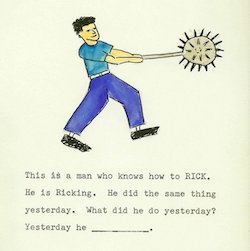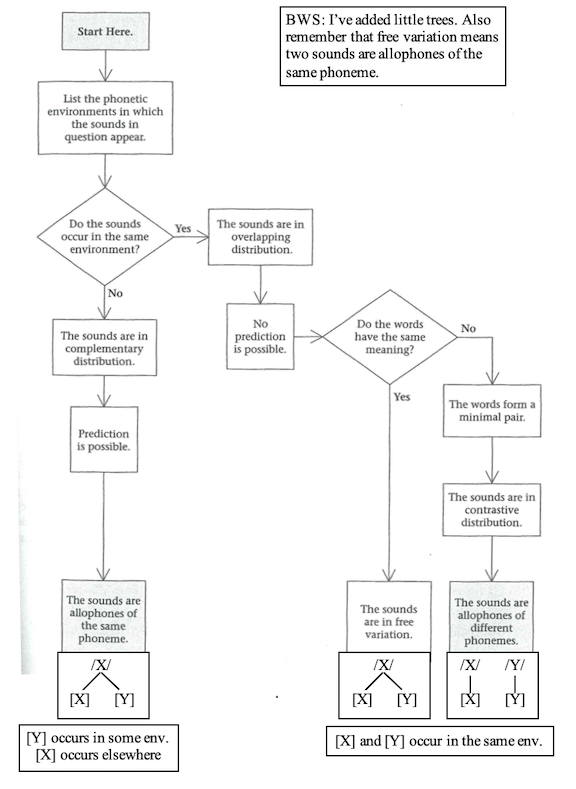
USC Advanced Undergraduate Phonology ✳︎ Fall 2019 ✳︎ Smith
Generative phonology and phonemic analysis
The concept of the “phoneme” (a functionally significant unit in the rigidly defined pattern or configuration of sounds peculiar to a language), as distinct from that of the “sound” or “phonetic element” as such (an objectively definable entity in the articulated and perceived totality of speech), is becoming more and more familiar to linguists. The difficulty that many still seem to feel in distinguishing between the two must eventually disappear as the realization grows that no entity in human experience can be adequately defined as the mechanical sum or product of its physical properties."
– Sapir (1933)
| Lexicon | /hæk/+/d/ | /su/+/d/ | /bræg/+/d/ |
| ↓ | ↓ | ↓ | |
| Grammar (simplified) | make /d/ voiceless after a voiceless segment | ||
| ↓ | ↓ | ↓ | |
| Surface forms | [hækt] | [sud] | [brægd] |
| Lexicon | /tiʧ/+/d/ | /go/+/d/ | /rɪk/+/d/ |
| ↓ | ↓ | ↓ | |
| Grammar (simplified) | make /d/ voiceless after a voiceless segment | ||
| ↓ | ↓ | ↓ | |
| Surface forms | [tiʧt] | [god] | [rɪkt] |


| [sut] | ‘suit’ | [pʌt] | ‘putt’ |
| [ʃɪn] | ‘shin’ | [ʃɪp] | ‘ship’ |
| [ʃɪp] | ‘ship’ | [but] | ‘boot’ |
| [pʊt] | ‘put’ | [ʃin] | ‘sheen’ |
| [sʊt] | ‘soot’ | [bʌt] | ‘butt’ |
| [luʒ] | ‘luge’ | [wuʃ] | ‘woosh’ |
| [lus] | ‘loose’ | [lut] | ‘loot’ |
| [noʊ] | ‘know’ | [tɛn̪θ] | ‘tenth’ |
| [ənoɪ] | ‘annoy’ | [mʌn̪θ] | ‘month’ |
| [ʌnjən] | ‘onion’ | [pæn̪θɚ] | ‘panther’ |
| [nʌn] | ‘nun’ | [krəsæn̪θəməm] | ‘chrysanthemum’ |
| [lefifi] | ‘darkness’ | [loleme] | ‘tongue’ |
| [selɛpɛ] | ‘axe’ | [molɔmo] | ‘mouth’ |
| [xobala] | ‘to read’ | [mmadi] | ‘reader’ |
| [lerumɔ] | ‘spear’ | [xoɲala] | ‘to marry’ |
| [loxadima] | ‘lightning flash’ | [diʤɔ] | ‘food’ |
| [dumɛla] | ‘greetings’ | [feedi] | ‘sweeper’ |
| [lokwalɔ] | ‘letter’ | [kʰudu] | ‘tortoise’ |
| [mosadi] | ‘woman’ | [podi] | ‘goat’ |
| [badisa] | ‘the herd’ | [hudi] | ‘wild duck’ |
| [lɪsən] | ‘listen’ | [wɛɫ̪θ] | ‘wealth’ |
| [luz] | ‘lose’ | [hɛɫ̪θ] | ‘health’ |
| [əlaʊ] | ‘allow’ | [fɪɫ̪θi] | ‘filthy’ |
| [əɡloʊ] | ‘aglow’ | [tɪɫ̪θ] | ‘tilth’ |
| [blɛnd] | ‘blend’ | [stɛɫ̪θ] | ‘stealth’ |
| [noʊ] | ‘know’ | [tɛn̪θ] | ‘tenth’ |
| [ənoɪ] | ‘annoy’ | [mʌn̪θ] | ‘month’ |
| [ʌnjən] | ‘onion’ | [pæn̪θɚ] | ‘panther’ |
| [nʌn] | ‘nun’ | [krəsæn̪θəməm] | ‘chrysanthemum’ |
| [wɛt] | ‘wet’ | [wɛɾɚ] | ‘wetter’ | [wɛɾəst] | ‘wettest’ | [wɛɾɪŋ] | ‘wetting’ |
| [bæt] | ‘bat’ | [bæɾɚ] | ‘batter’ | [bæɾɪŋ] | ‘batting’ | ||
| [sæd] | ‘sad’ | [sæɾɚ] | ‘sadder’ | [sæɾəst] | ‘saddest’ | ||
| [ʃut] | ‘shoot’ | [ʃuɾɚ] | ‘shooter’ | [ʃuɾɪŋ] | ‘shooting’ | ||
| [fid] | ‘feed’ | [fiɾɚ] | ‘feeder’ | [fiɾɪŋ] | ‘feeding’ | ||
| [laʊd] | ‘loud’ | [laʊɾɚ] | ‘louder’ | [laʊɾəst] | ‘loudest’ | ||
| [wɛd] | ‘wed’ | [wɛɾɪŋ] | ‘wedding’ | ||||
| [lʌɪk] | [ʤaɪb] | [klaɪm] | [raɪð] |
| [flʌɪt] | [tɹʌɪp] | [ʃaɪn] | [waɪd] |
| [snʌɪp] | [lʌɪf] | [baɪ] | [əblaɪʤ] |
| [laɪv] | [ʌɪs] | [spaɪ] | [saɪd] |
| [rʌɪt] | [rʌɪɾɚ] | ‘writer’ |
| [raɪd] | [raɪɾɚ] | ‘rider’ |
| [slaɪd] | [slaɪɾɪŋ] | ‘sliding’ |
| [slʌɪt] | [slʌɪɾɪŋ] | ‘slighting’ |
| Type | Phonemic analysis | Predictable? | Contrast? | What to look for |
|---|---|---|---|---|
| Contrast (that isn’t neutralized) | multiple phonemes | unpredictable | contrastive | (near-)minimal pairs |
| Allophony (that isn’t free variation) | multiple allophones (predictable) | predictable | non-contrastive | complementary distribution& alternations |
| Positionalneutralization | multiple phonemes that share an allophone | predictable(but not totally predictable) | contrastive (contextually-limited) | (near-)minimal pairs & alternations |
| Freevariation | multiple allophones (unpredictable) | unpredictable | non-contrastive | overlapping distribution& alternations |
A final note: terminology can be confusing, making tables and flowcharts imperfect.
In the end, our generative model (rules or constraints) will guide our phonemic analysis. The guiding principles will be “account for predictable things using rules or constraints” and “come up with an analysis that works.”
This property is called biuniqueness: every phonemic representation must be able to be mapped to a unique phonetic representation, and every phonetic representation must be able to be mapped to a unique phonemic representation. There was a way to do positional neutralization and respect biuniqueness, and it was famously argued against using Russian data by Morris Halle at the 1957 LSA. Stephen Anderson has written about the famous Russian example, what actually happened, and puts the 1957 argument in context. ↩